DowntoEarth
ENVIRONMENTAL INFORMATION CENTER







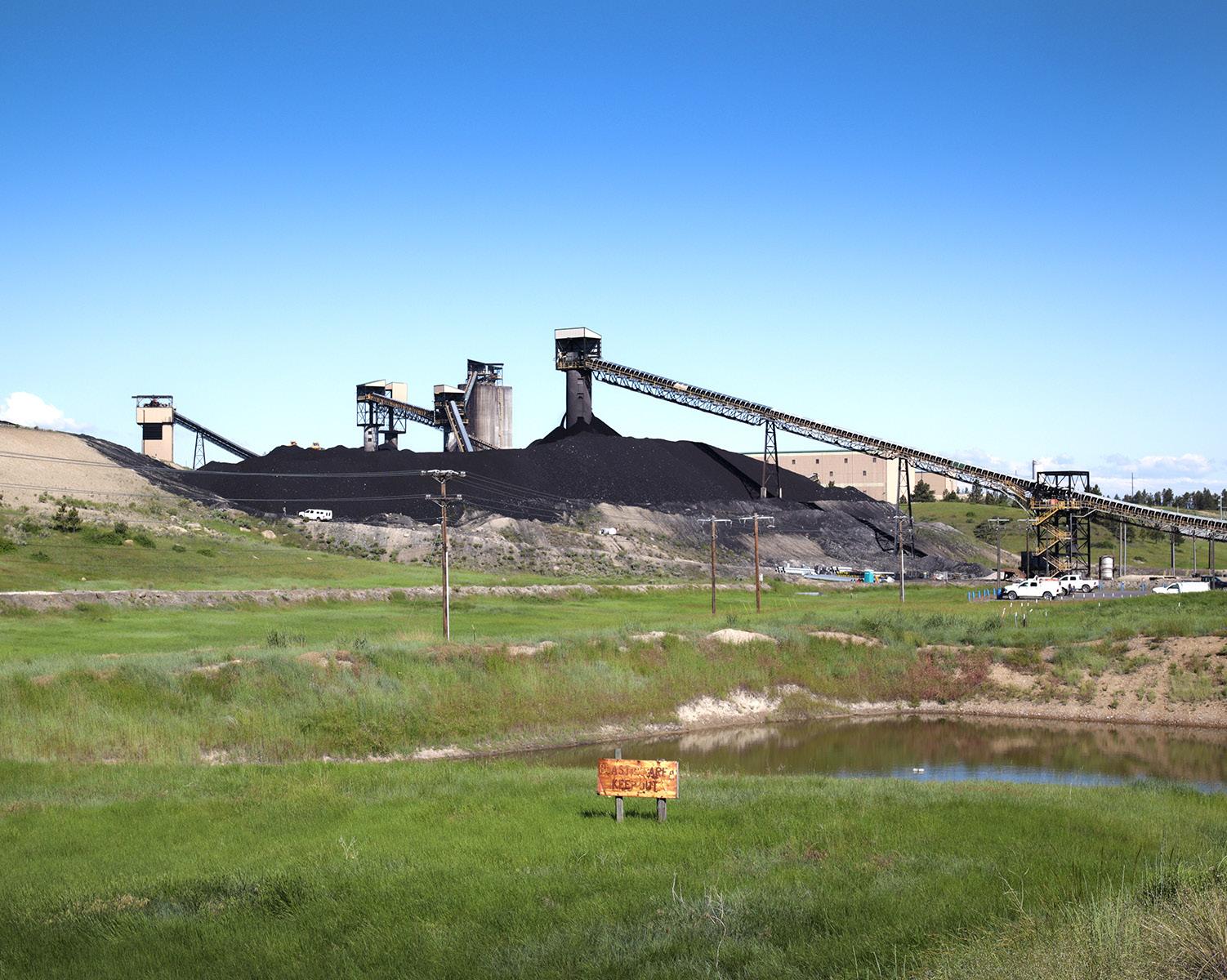
Board PrEsIdEnt: Kathy Juedeman
Board MEMBErs: Gary Aitken
Dan Belcourt
Grace Gibson-Snyder
Diana Hammer
Jim Sayer
Roger Sullivan
Beth Taylor-Wilson
Neal Ullman
Jessie Wiles
MEIC staff: Laura Collins
Nick Fitzmaurice
Anne Hedges
Shannon James
Derf Johnson
Cari Kimball
Peyton Olson
Katy Spence
Julie Wintersteen
MaI lIng: P.O. Box 1184 Helena, MT 59624
by Beth Taylor-Wilson
“
There is No Wealth on a Dead Planet.” So said a sign I saw at a recent climate rally full of young activists. That simple sentence has had me pondering its truth ever since. When our own Montana kids — the Held plaintiffs — argued their Constitutional right to a “clean and healthful environment” and won their momentously groundbreaking case last summer, the consequences and legal ramifications rippled out across the world. As a climate activist, there are times when the sheer volume of bad news makes it hard to find optimism. But, I have been discovering it recently from the efforts and actions of the Held plaintiffs and other young Montanans.
A few weeks ago, there was a small ruckus outside my home in Missoula County after a nearby elementary school let out. Four or five young elementary schoolaged children attempted a rescue of some baby ducklings on their way home from school. The boys were a team, talking to one another, working together, shooing away domestic cats and a curious golden retriever, all while gently trying to guide the duckling babies back to their frantic mamma. The family had become separated in an irrigation ditch by my house, and poor mamma duck had lost a couple of stragglers to the hazards along the way. Why a mother duck would choose an irrigation ditch as a home for her duckling babies says volumes about human encroachment into animal habitats everywhere. Mamma was flying up and down the ditch, very distraught, so one boy went right into the ditch with his shoes on to steer the babies back toward mom. Those boys cared about that duck family.
Members of another climate group I support recently kicked around the idea of staging a “mock” funeral for Glacier National Park's vanishing, iconic namesake. According to some Flathead Valley members, several Columbia Falls high schoolers liked the idea and expressed interest in involvement. Those high school students care about our disappearing glaciers.
So, thanks to these young people who gave me back my optimism. Thanks again to the Held plaintiffs. And as an MEIC board member, all MEIC members owe
gratitude and thanks to MEIC’s many young members and staffers, bringing wonderful ethics and smarts to the climate crisis. Finally, thanks to the many other young people in our beautiful state who care about much more than material wealth. They know, even if their parents don’t, that a healthy livable planet is far more important to their future than things money can buy. The Held case has educated many Montana parents and grandparents. Tremendous hope was expressed by the expert witnesses at the Held trial, whether it was by professors from Montana’s own flagship universities or the testimony of a worldrenowned atmospheric scientist from Stanford. We can still save our planet and all the beings on it that enrich our lives daily. We can do it, together, with our children. And if you’re still looking for a gift suggestion for young Montana graduates, consider gifting an MEIC membership!
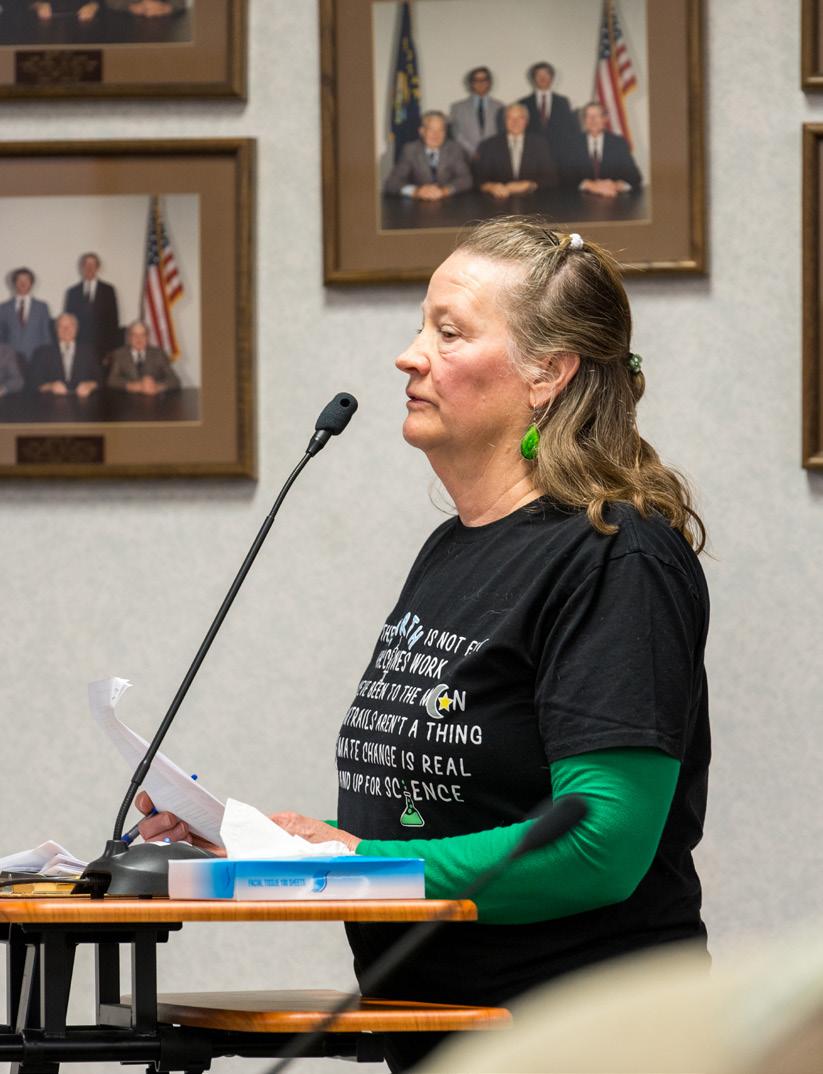

Beth Taylor-Wilson grew up in Missoula, which had some of the worst temperature-induced winter “inversion” air pollution in the country in the '60s. Thanks to activists like the Gals Against Smog and Pollution (GASP), who numbered Beth’s mother as a member, Missoula’s air became far cleaner and healthier. Environmental activism and stewardship is in her family DNA, and Beth is honored to work with the state’s premier environmental watchdog.
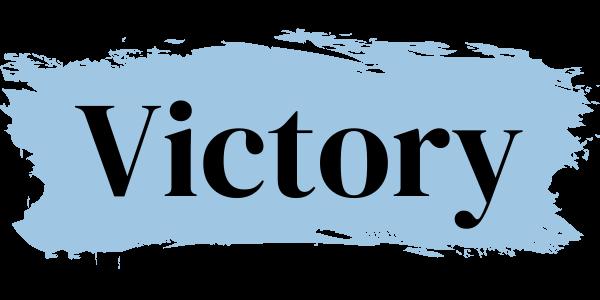

by Derf Johnson
Protecting Montana’s water is no easy task. It’s about tenacity, buckling up for the long-haul, being nimble and opportunistic, and leveraging our collective power to steer the ship towards clean water. All the while, major headwinds work against us, including a hostile legislative majority that panders to extractive industries. When victories do come, they are a reason to celebrate and remind ourselves that progress can be made, however incremental. Such a victory happened in late March of this year, when the U.S. Office of Surface Mining (OSM) rejected changes to Montana’s Surface and Underground Reclamation Act — the law that regulates coal mining in Montana — that, if approved, would have dramatically weakened water quality protections at and near coal mines.
Readers of Down to Earth may recall that the 2023 Montana Legislature passed, and Gov. Greg Gianforte signed, HB 576 (Rep. Rhonda Knudsen, R-Culbertson). The bill came at the behest of the coal mining industry and dramatically changed the definition of “material damage,” a critical component of coal mining laws that protects water near coal mining operations. Most importantly, the bill removed clear and concise language that defined material damage, in part, as a violation of water quality standards, instead replacing it with a complex, site-specific analysis that would have been incredibly difficult to enforce. While it passed, the bill did not go unchallenged – MEIC, our organizational partners, and thousands of our collective members and supporters put up a strong fight.
Thankfully, Montana doesn’t have the final say over coal mine regulations, as we participate in a relationship of “cooperative federalism” with the federal government in regard to the permitting and regulation of Montana’s mines. Any changes to Montana’s regulatory program must go through an approval process at OSM, which includes a public comment period and a hearing. OSM approval must occur before the change actually becomes law. Montanans showed up in droves in strong opposition to the changes, and OSM was forced to listen. MEIC and our partners packed the hearing room, submitted comments from all four corners of the state, and submitted technical comments on the more dangerous aspects of HB 576. MEIC and our partners also brought suit in U.S. District Court to assure that the law was not implemented unless and until OSM had conducted its evaluation process.
Thankfully, OSM conducted a full, fair evaluation of HB 576 and concluded in March that the legislation wholly failed to meet the minimum requirements of federal law. With HB 576’s rejection, Montana’s strong water quality protections remain intact, which if adequately enforced prevent coal mining operations from violating water quality standards (what a novel concept!). This critical victory will help to assure that, as coal mining operations wind down in Montana, we maintain clean water. This victory would not have been possible without the steadfast support and coordination of our partners at Earthjustice and the Northern Plains Resource Council.

by Derf Johnson
In a historic shift, indicative of the dramatic movement towards cleaner sources of energy, the Biden Administration recently announced that it would no longer lease federal coal in the Powder River Basin (PRB) of Montana and Wyoming. The announcement was made through the release of a federal environmental impact statement accompanying the Resource Management Plans (RMPs) for the field offices in Miles City, Montana, and Buffalo, Wyoming. The decision to wind down federal coal leasing in the PRB did not come without pressure. MEIC and our coalition partners doggedly pursued an end to federal leasing over three presidential administrations and several rounds of litigation. This decision really represents a sea change in America’s pursuit of clean energy production and an important milestone in decarbonizing our energy system.
Since the 1970s, the PRB has been a leading juggernaut of U.S. coal production. At its height in 2008, the PRB alone supplied close to 500 million tons annually (42%) of the 1.7 billion tons of coal being burned in boilers across the U.S. for electricity production. Since that time, coal production in the PRB has nearly halved, with 2024 estimates predicting even steeper declines. Nationwide, coal production totaled 535 million short tons (MMst) in 2020, and the Energy
Information Administration is predicting that 2024 will see further cuts to approximately 500 million tons.
This is good news. The PRB is the largest single-source of carbon dioxide pollution in the nation, with almost all of the coal mined in the region used for electricity production. Further, more than 85% of all federal coal produced in the U.S. comes from the PRB,
which stretches across more than 13 million acres.

How was this victory secured? In 2022, in response to a challenge from MEIC and our partners, a federal judge in Montana found that the RMPs failed to address the public health consequences of allowing massive amounts of coal, oil, and gas production from public lands and minerals in the PRB, including approximately six billion tons of low-grade, highly polluting coal over 20 years. In the ruling, U.S. District Judge Brian Morris found that the Bureau of Land Management (BLM) failed to comply with a previous court order directing the agency to account for the environmental and human health impacts of burning publicly owned coal. The judge also held that BLM failed to consider alternatives that would limit or end new coal leasing in the PRB in violation of the National Environmental Policy Act. The court ordered BLM to redo its environmental analysis, which is the product of BLM’s recent decision.
Undoubtedly, MEIC owes a debt of gratitude to our partners at Earthjustice, the Powder River Basin Resource Council, the Western Environmental Law Center, the Sierra Club, the Center for Biological Diversity, Northern Plains Resource Council, WildEarth Guardians, and the Western Organization of Resource Councils.

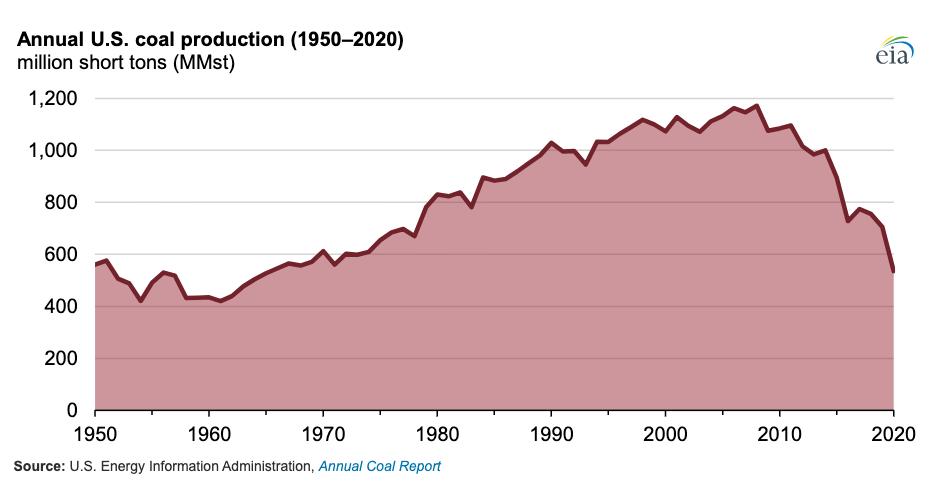
by Derf Johnson
Barrels upon barrels of ink have been spilled on news stories covering the criminal enterprise in the Bull Mountains known as Signal Peak Energy. The owners of the Bull Mountains coal mine, located in Musselshell and Yellowstone Counties in southeastern Montana, are aiming for it to be the largest underground coal mine in the U.S. The company’s history reads like a John Grisham novel. Signal Peak is currently on federal criminal probation for willfully lying to federal mine regulators about serious injuries to workers and illegally dumping mine waste. Signal Peak, its executives, and its owners also have an arm-length rap sheet of criminal activity and non-compliance with environmental and worker safety laws, chronicled recently in the New York Times: “A Faked Kidnapping and Cocaine: A Montana Mine’s Descent Into Chaos.”
The three equal owners of the mine include the Boich Companies, FirstEnergy of Ohio, and private commodities trading firm Gunvor. Gunvor, which is registered in Cyprus and headquartered in Switzerland, has been accused by the U.S. Department of Justice in assisting Vladmir Putin in hiding his fortune. Gunvor has also been accused of being involved in a Belarusian oil smuggling scheme; was ordered by Swiss authorities to pay close to $100 million for failing to prevent its employees from bribing officials in Cote d’Ivoire and the Republic of Congo; and was ordered this past April to pay a $660 million fine by the federal district court in New York for a bribery scheme in Ecuador.
FirstEnergy Corp. is currently on probation for what the U.S. Attorney for the Southern District of Ohio has called “likely the largest bribery and money-laundering scheme ever in the state of Ohio.”
FirstEnergy admitted spending over $60 million to bribe legislators and energy regulators to roll back a clean energy law and subsidize its power plants, ultimately agreeing to pay a fine of $230 million. Two former FirstEnergy executives have been indicted and the former Speaker of the Ohio House is serving a 20-year jail term. Signal Peak’s third owner, Boich,
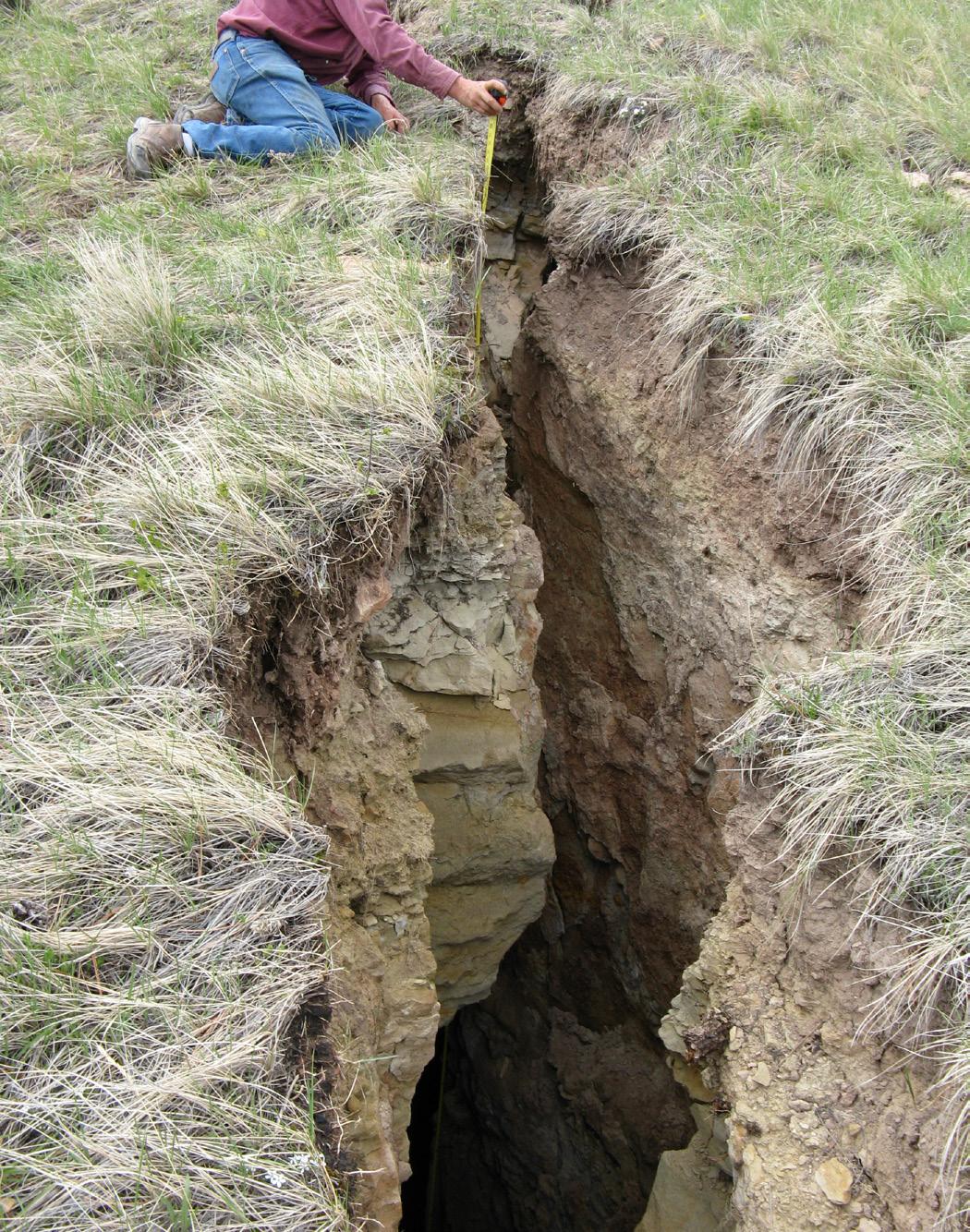
provided the seed funding for one of the dark money organizations at the center of the Ohio scandal, though he has not been indicted.
Against this sordid backdrop, MEIC and our partners have been working to protect the water in the Bull Mountains and our climate by holding the company accountable for the serious damage it is causing. Our efforts ultimately have caused Sen. Steve Daines to introduce legislation to basically give a free pass to Signal Peak to continue destroying water resources, harming ranchers, causing land subsidence, and polluting our climate, without repercussions.
Shockingly, Sen. Daines has introduced Senate Bills 4431 and 4432, which are designed to reinstate a failed environmental impact statement associated with Signal Peak and to allow the mine to bypass normal environmental laws and protections. Apparently, Sen.
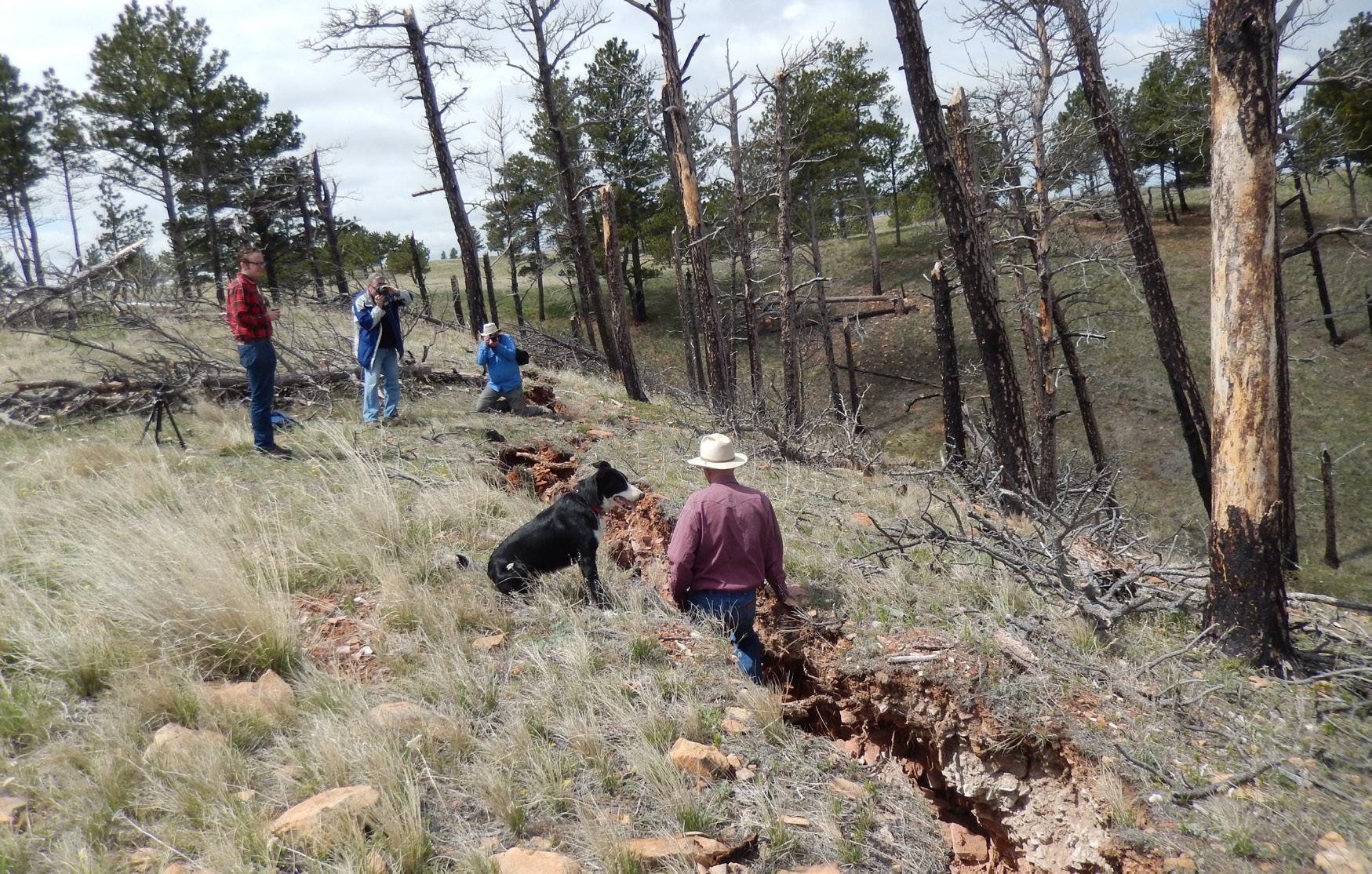
Daines believes that if a coal mining corporation can’t comply with the law, they should just be exempted from compliance entirely. Sen. Daines also introduced Senate Bill 4444, a cynical bill that would transfer huge swaths of public lands and mineral rights in the Bull Mountains into the ownership of a private family. In exchange, the family would relinquish the mineral rights (but not the surface rights) of lands in Big Horn County to the federal government to be held in trust for the Crow Tribe. The bill is entitled the “Crow Revenue Act,” but the version released as of the time of this writing did not include any actual revenue opportunities for the Crow Tribe. While Sen. Daines’ press release said the Tribe would receive revenue from the Signal Peak Mine, the bill text as introduced does no such thing.
Instead of being a sycophant for the most corrupt company in Montana and perhaps the nation, Sen.
Daines should instead focus on bringing economic opportunities to southeastern Montana through the clean energy transition. Clean energy is growing rapidly, and with the passage of the Inflation Reduction Act, there are enormous opportunities for “energy communities,” such as Yellowstone and Musselshell Counties, to benefit from clean energy development. Sen. Daines should also assure that the Crow Tribe receives the funding it needs to fully engage in the energy transition and develop clean energy resources on its own land.

As record-breaking temperatures and atmospheric concentrations of greenhouse gases (GHG) reach unprecedented levels (426.9 ppm at the time of this writing), the U.S. Environmental Protection Agency has made a second attempt to regulate GHG emissions from fossil fuel-burning power plants. Fossil fuel power plants are the single largest industrial emitter of GHG, contributing 25% to annual emissions in the U.S. While the rule doesn’t go nearly far enough for methane-burning gas plants and will take too long to implement for coal plants, it is a critical step in the right direction. For new gas plants, GHG reduction requirements will vary based upon a plant’s annual operations. The more they operate, the more stringent the GHG reduction requirements. The largest plants will need to capture and sequester 90% of their CO2 emissions by 2032. For coal plants, any plant without a closure date before 2039 must also reduce its CO2 emissions by 90% by 2032. If a plant is committed to closing prior to 2032, it will have no CO2 emission reduction requirements. There are many more details in the rule, some ability for evasive behavior by states, and the expected legal challenges by the likes of Montana’s Attorney General Austin Knudsen. Despite all of this, MEIC will work to ensure this rule is implemented as quickly and honestly as possible. — A.H.
by Anne Hedges
The Colstrip plant in eastern Montana is the nation’s number one bad actor for toxic air pollution. Colstrip Unit 4 has the highest emission rate of toxic pollutants of any coal-burning unit in the nation. Its emissions rate is 50% higher than the next closest coal unit. Colstrip Unit 3 is not far behind, having the third highest toxic air emissions rate in the nation.
The Colstrip plant is one of a handful of plants that has not installed modern pollution control technology to limit its toxic emissions. In fact, there are 170 coalburning units in the country that use the same technology as Colstrip, but it is the only one that hasn’t installed industrystandard control technology to reduce
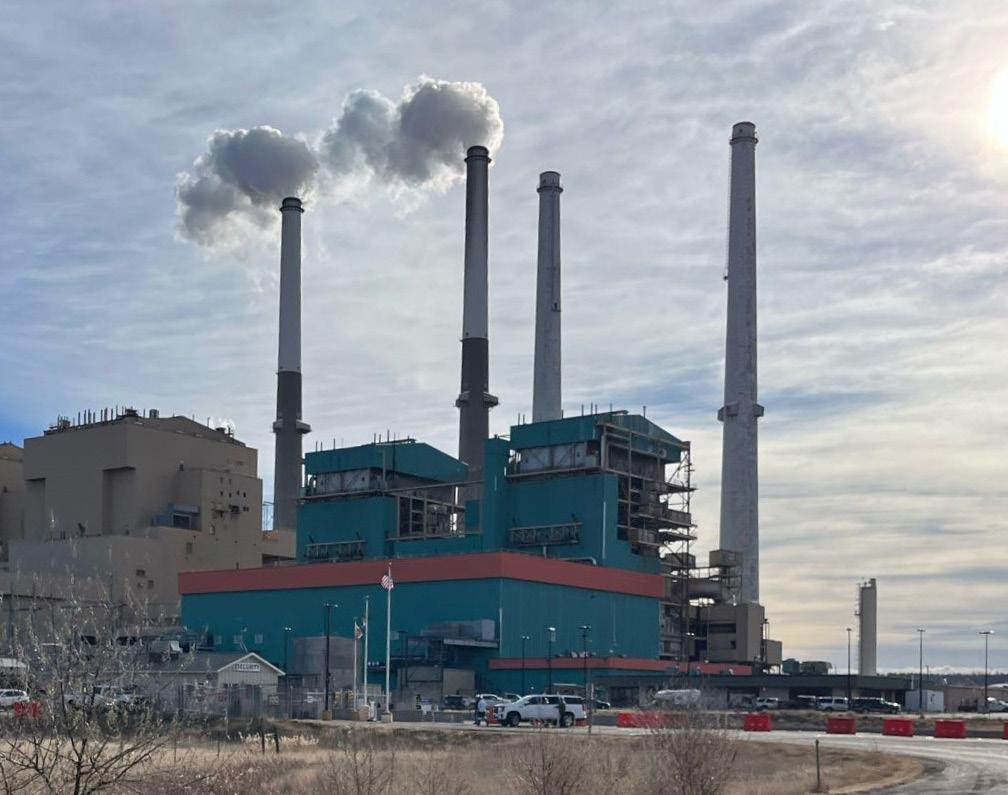
emissions of lead, arsenic, chromium, and more.
As a result, the Colstrip plant's toxic emissions are staggeringly high.
Colstrip Units 3 and 4 were shut down for most of the summer of 2018 because the plant couldn’t meet the air pollution requirements for toxins. Now, the U.S. Environmental Protection Agency (EPA) has updated those air pollution requirements for coal-fired power plants, and the Colstrip plant should not be made an exception.
From 2012-2022, the Colstrip plant released into the air:
3.3 tons of lead
1.45 tons of arsenic
2.1 tons of chromium
14 tons of manganese
2 tons of nickel
6 tons of selenium
On April 24, 2024, the EPA took a long overdue step to limit mercury and air toxics from coal-fired power plants. The updated Mercury and Air Toxics Standards (MATS) will limit air emissions of mercury from facilities that burn lignite coal and toxic air pollutants such as lead, arsenic, nickel, and more. While the new mercury standard will not impact Montana power plants because they burn subbituminous coal, the rule will require significant updates at the outdated Colstrip plant because it has the highest emission rate of toxic air pollutants of any coal plant in the nation.
The new MATS rule is a long time coming. Owners of coal-fired power plants have spent decades fighting EPA’s efforts to limit toxic air pollution from burning coal. They’ve argued that decreasing pollution is unnecessary and expensive – standard tropes of an industry that is more concerned about corporate profits than people’s health. Polluters and their allies are also arguing that EPA is not giving plant owners enough
time to comply with the updated standard, but this argument should fall flat.
Congress directed EPA to limit harmful pollutants from industrial operations in the 1990 Clean Air Act Amendments (CAAA). Despite being the largest mercury polluters in the nation, power plant owners were able to stall the adoption of any limits on toxic emissions from coal-burning plants until 2012 when Pres. Barack Obama’s EPA found that it was “appropriate and necessary” to limit these harmful emissions. The 1990 CAAA required EPA to establish limits on hazardous air pollutants for each class of industrial operations based upon the maximum level of emissions reductions that were being achieved by similar facilities. These standards were then required to be updated every eight years to ensure that public health would benefit as technology improved. If so, EPA had to revise the standard to require all sources to limit their emissions to a level that the best operators were already achieving. Once EPA revised a standard, Congress required EPA to require all sources meet that standard within three years. This same three-year timeframe for compliance with a new toxic air pollution standard applies to refineries, chemical plants, cement kilns, and every other type of industrial source that pumps high levels of toxins into the air each year. Coal-fired power plants are no exception; they have just managed to stall such regulation longer than other industrial operations.
Power plant owners have challenged the rule at every step, from when it was first introduced to the most recent update of the rule. Interestingly, nearly every power plant in the nation is already limiting pollution to a level that is lower than the one recently set by EPA. Despite this, the owners of the most polluting plants –like the Colstrip plant – are continuing to argue that it is not fair that they should have to limit pollution to levels already achieved by the vast majority of plants.
The Trump Administration tried and failed to revoke the Obama era decision that it was appropriate and necessary to limit toxic air pollution from power plants. In 2023, the Biden Administration, in compliance with the 1990 CAAA, finally proposed emission limits that were based on what the best performing power
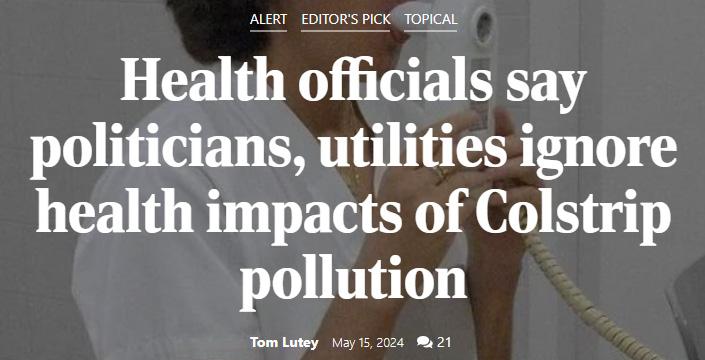
plants in the nation were achieving for limiting toxic pollution. EPA finalized its proposal in April, making some changes to its final rule based upon comments from industrial polluters.
Now, some states, including Montana, are challenging the rule, once again arguing that it is unnecessary and too expensive to protect public health from mercury, arsenic, lead, and other acutely toxic substances. Considering the cost a family must pay for treatment for the most common cancers associated with high arsenic levels (skin, bladder, and lung cancer), requiring plants to limit their pollution to the same level that most other plants are already achieving is imminently reasonable. The law is clearly achievable, and so states are not arguing that EPA set the standard improperly. Instead, they are arguing that MATS will create hardship for some utilities. The owners of Colstrip are griping that the new standard will cost too much. For a plant that appears to pays more than $200 million each year for fuel, it’s unconscionable that the owners aren’t willing to invest in public health protections. The real question is: how many people will courts allow to get sick in order to protect a few bad actors who don’t want to limit their toxic emissions?
Montanans and nearby Tribes deserve clean air just as much as other places in the nation. We also deserve continuous emissions monitors that will guarantee lower levels of toxic pollution are released from the plant on a continuous basis, not just once a quarter as the plant currently measures compliance.
Our Congressional delegation needs to hear that you support public health and clean air. Send a message to our Senators and Representatives and sign a petition online here: https://tinyurl.com/MontanaMATS.


by Anne Hedges
Is the Montana Department of Environmental Quality (DEQ) required to consider climate change when it analyzes a large methane-fired power plant’s impact on the environment? DEQ and NorthWestern Energy say no. MEIC disagrees.
In September 2021, Earthjustice, on behalf of MEIC and Sierra Club, filed a legal challenge in state district court arguing that DEQ’s approval of NorthWestern Energy’s gas plant near Laurel violated state law for failing to analyze the potential climate impacts of NorthWestern’s proposed 175-megawatt gas-fired plant on the banks of the Yellowstone River. The Montana Environmental Policy Act (MEPA) is one mechanism that implements Montanans’ Constitutional right to a clean and healthful environment, yet DEQ ignored climate impacts in its environmental analysis. In April 2023, a district court judge ruled in our favor, finding that the state had an obligation to consider climate change in the MEPA analysis.
In response to the district court ruling, three things occurred. First, NorthWestern Energy and the state appealed the decision to the Montana Supreme Court arguing that the state had no obligation to consider climate change when permitting the plant. Second, Northwestern convinced the Montana Legislature to suspend its rules and pass a new law that prohibits the state from considering climate change in any state agency’s MEPA analysis. Third, DEQ began the MEPA process to comply with the court order and consider climate change and lighting issues related to NorthWestern’s plant.
In August 2023, a state district court ruled in the youth climate case, Held v. State of Montana, that the new law outlawing consideration of climate change under MEPA violated the youth’s Constitutional right to a clean and healthful environment. The court found that DEQ was required to consider climate
change when it analyzed the impacts of the plant. While welcome news, what didn’t make the papers was DEQ’s abandonment of the MEPA process for the gas plant. DEQ ignored the court order and simply stopped working on the MEPA analysis, instead putting its energy into a Supreme Court appeal of the decision and a lengthy process to reach a modicum of agreement on ways to clarify the overall MEPA process. (Unfortunately, the DEQ process still doesn’t address how the state should consider climate change in its MEPA analysis or decision-making. See article on pg. 20.)
In May 2024, the Montana Supreme Court heard oral arguments on the appeal of the district court decision. Jenny Harbine with Earthjustice argued eloquently about the state’s obligation to analyze climate impacts in the permitting of large projects that could contribute to the climate crisis. By contrast, the state’s and NorthWestern’s arguments were troubling and misleading. NorthWestern argued that DEQ had no obligation to analyze climate change impacts since state permitting laws didn’t directly require climate analysis, and DEQ was not authorized by the legislature to mitigate climate harms. This argument is terribly flawed, as MEPA has always required analysis and disclosure of a project’s potential impacts to cultural and historic resources; fish and wildlife resources; and public safety, none of which have underlying permitting statutes. Under NorthWestern’s argument, these issues would no longer be required to be analyzed and disclosed to the public in the MEPA process.
The state’s argument was equally flawed, basically arguing that since it didn’t understand the specifics of what would be included in a climate impacts analysis, it shouldn’t be required to conduct such an analysis. The court will rule on this case in the coming months.

by Derf Johnson
For over a decade, MEIC and our partners have engaged in a prolonged fight to prevent the Smith River Mine (aka the Black Butte Copper Mine) from ever moving forward and threatening the water quality and natural values of the Smith River watershed. From courtrooms to legislative committee meetings to public hearings, we’ve tried every tool in the shed to prevent the worst impacts of the mine. To date, the mine hasn’t begun any real mining, and the long-term efficacy of the project continues to remain in doubt. However, should the mine be permitted and production is actually established, it will gain a foothold in the Smith River valley that will likely be impossible to slow or stop. Such has been the tactic of mining companies in the past in Montana: proposing small projects with relatively small footprints, getting permits, opening up shop, and then dramatically expanding. Sandfire has made such inferences when one of its previous executives was caught on tape suggesting that the mine had an enormous opportunity to expand and to create a “50-year mining district.”
Part of Sandfire’s plan to create the 50-year mining district is to expand onto adjacent public lands. To date, the company has acquired close to 700 acres of public land mining claims on U.S. Forest Service lands that would allow for the company to expand onto federal lands. These claims are directly adjacent to the Smith River, include numerous tributaries of the river, and are some of the most unparalleled, wild, and dramatic lands you can find in Montana. The idea of this landscape turning into an industrialized wasteland and impacting the Smith River — Montana’s only permitted recreational river — is simply appalling.
Recognizing the threat, MEIC and our partners have pushed for years for the federal government to execute a “mineral withdrawal,” which would remove the lands from potential mining activity. Recently, a number of partner organizations, including MEIC, Montana Trout Unlimited, Trout Unlimited, American Rivers, Montana Mountain Mamas, the Montana Wildlife Federation, and Wild Montana, launched the Smith River Public Lands Coalition in the
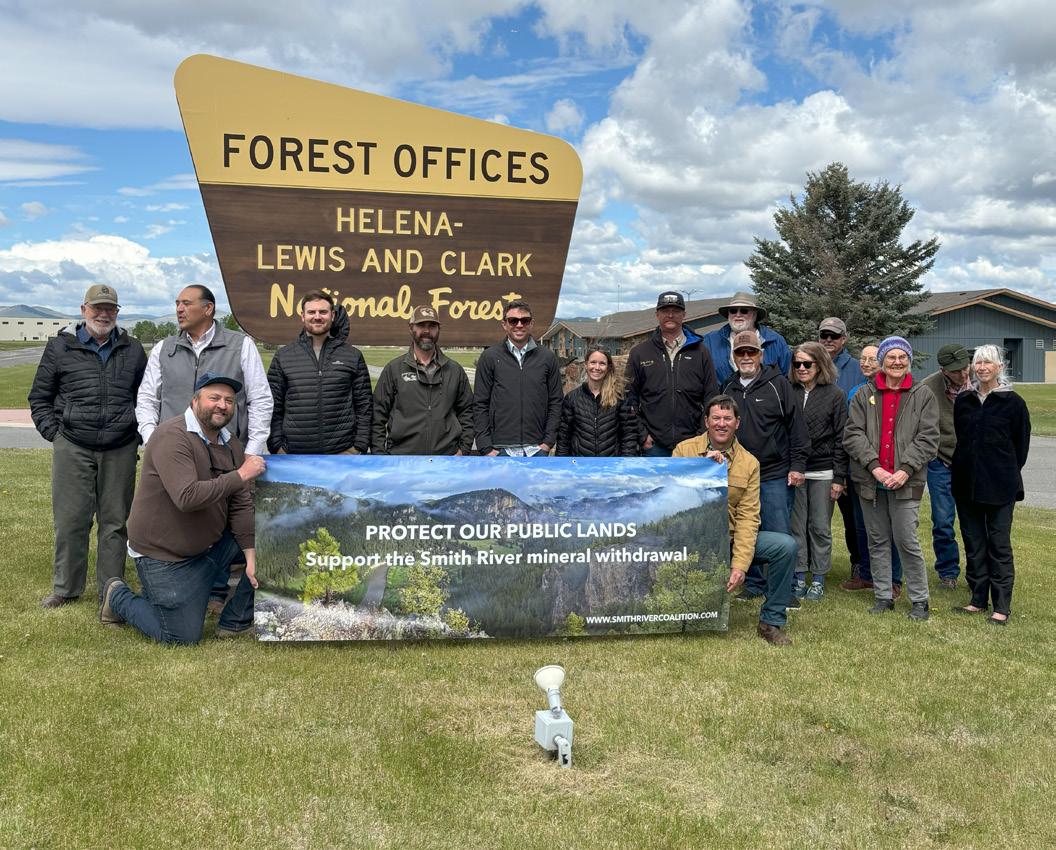
effort to withdraw the lands permanently from mineral exploitation. More information on the coalition, including a petition to the U.S. Forest Service, can be found at www.smithrivercoalition.com.
Needless to say, the idea of protecting the Smith River is incredibly popular across Montana. Both the Fort Belknap Indian Community and the Confederated Salish and Kootenai Tribes have passed resolutions in support of the withdrawal. In addition, a recent poll by the University of Montana found that 73% of Montanans said they support a public process by the U.S. Forest Service before allowing any new hardrock mining at the headwaters of the Smith River. On May 21, several Montanans and organizations held an event outside the Lewis and Clark National Forest’s Office in Helena, where close to 10,000 petition signatures were delivered in support of the withdrawal.
Building broad coalitions to protect Montana’s landscape takes people and time. We urge you to not just sign the petition, but to get engaged in support of a mineral withdrawal for the public lands surrounding the Smith River watershed. You can reach out to MEIC Deputy Director Derf Johnson for more information: djohnson@MEIC.org. There’s going to be plenty to do over the next year in order to see that the Smith is protected for generations to come, so it’s time to roll up our sleeves and get to work.


by Nick Fitzmaurice
Previous issues of Down to Earth have explored the concept of the energy transition, which entails decarbonizing local and global energy systems to address the climate crisis. This transition includes numerous interrelated components that must be achieved in combination. Parts one and two of this series addressed electrification and electricity decarbonization. This third installment of Montana’s Energy Transition unpacks efficiencies and load reduction, focusing on demand side management (DSM) as a key component of decarbonizing energy. Look for future installments of Montana’s Energy Transition in subsequent issues of Down to Earth, diving into transmission infrastructure expansion, power sharing across the West, and other pieces of the energy transition!
With all else held equal, electrifying energy in Montana could lead to dramatically increased electric loads throughout the energy system. Add to that the projected increase of data centers and cryptocurrency mining operations, and the electrical grid could be strained beyond its designed limits. Whether or not these growing loads are warranted is a different discussion, but the truth of the matter is that today’s build-out rate of carbon-free energy resources may not keep up with current load growth projections. It is therefore essential to pursue DSM and efficiency measures to ensure demand does not exceed generation capacity and to prevent an overbuild of expensive, unnecessary generation infrastructure. Efficiencies seek to achieve the same functional output with a lower energy input, while demand response programs are designed to encourage consumers to alter their level and pattern of electricity use based on the overall load in the system at a given time.
Efficiencies can most accessibly be achieved in homes and businesses by replacing outdated household appliances. At scale, adopting better building energy efficiency codes at the municipal, state, and federal

government levels is a long-term solution for implementing deep-rooted efficiencies. Efficiency overlaps with electrification (discussed in Montana’s Energy Transition Part 1) in a number of areas, such as installing highly efficient electric heat pumps and induction stoves. However, the opportunities for efficiency upgrades extend to all electric appliances and beyond. Consider the highest energy guzzlers such as washers and dryers, refrigerators, dishwashers, microwaves, and any other appliances cluttering countertops and cabinets. Newer, highly efficient appliances often improve user experience while using less energy. LED lighting is another accessible efficiency upgrade, greatly mitigating the energy consumption of incandescent and fluorescent bulbs. Energy Star is a nationally recognized certification that can help identify energy-efficient home appliances. Efficiency can be realized indirectly as well by minimizing the amount of energy a building loses to the surrounding environment. Ensuring proper insulation can passively hold living and working spaces at a comfortable temperature, reducing energy consumption for heating and cooling dramatically and saving money in the process. Replacing old windows with highly insulative multi-pane windows and ensuring that all exterior doors adequately seal with their frames are a couple of great places to start. The federal Inflation Reduction Act (IRA) includes ample rebates and incentives for building energy efficiency

improvements, so don’t miss out!
At a more macro level, containing urban sprawl for more walkable and bikeable cities can reduce the energy needed for transportation. Electric vehicles are great, but it is also necessary to move away from car-centric development to reduce energy needs and improve quality of life. Where electric transportation is still necessary, single occupancy vehicles can be limited through the implementation of comprehensive public transportation systems, such as integrating electric bus fleets with electric passenger rail both within and between urban centers.
While efficiency improvements can reduce overall energy consumption, utilities can also pursue DSM through pricing structures that disincentivize expensive electricity use during peak demand periods. Utilities often build capacity infrastructure to meet the most extreme energy needs, but electricity demand varies dramatically both throughout a given day and throughout a given year. For example, a daily peak in demand is experienced in the late afternoon,
while seasonal winter and summer demand peaks are experienced on the coldest and hottest days of the year. Instead of building excessive costly infrastructure that only runs to keep the lights on during infrequent extreme peaks and sits dormant the rest of the year, load shifting redistributes these peaks while load reduction shaves down these peaks for a smoother and lower demand curve. From a utility perspective, load shifting can look like time-of-use tariffs or real-time pricing, for which customers face higher electricity rates during peak periods, incentivizing a shift of non-essential consumption habits away from these peaks. Under these structures, smart appliances such as water heaters or electric vehicle chargers could be programmed to respond to utility data, kicking in when electricity prices are at their lowest (generally overnight). Utilities can also implement load reduction by offering curtailment services to non-essential, heavy-use customers such as a cryptocurrency mining operation or industrial manufacturing facility that agree to shut off or dial back their operations during seasonal load-peaking events.

M any fossil fuel proponents seek to protect their profits, pushing infeasible solutions such as carbon capture and storage (CCS) as a lifeline to expensive and polluting power plants. CCS is an expensive and unproven band-aid fix on climate pollution that ignores the real possibilities available in a rapidly shifting energy landscape. Atmospheric removal of CO2 may be necessary in the global push for net zero greenhouse gas emissions, but this is distinct from capture at a source such as a coal-fired power plant or gas processing facility (see article on pg. 16). Removal decreases CO2 concentration in the atmosphere, while capture only partly reduces additional emissions into the atmosphere while that concentration continues to climb. Some drilling companies have been taking advantage of CCS tax incentives for use in enhanced oil recovery (EOR) schemes, wherein CO2 is captured or extracted from below ground and injected elsewhere into the ground to access additional oil for combustion. This Carbon Capture Utilization and Storage increases overall emissions, antithetical to climate action. The U.S. Department of Energy analyzed the potential use of CCS at the Colstrip Power Plant in 2018 and determined that it would cost $1.3 billion to reduce only 63% of the CO2 emissions from the two units that remain in operation while decreasing the plant’s energy output.
by Anne Hedges
When
Public Service
Commissioners run for office, they always promise to ensure that Montana’s energy system will be reliable and affordable. Yet in recent years, as soon as Commissioners enter the door, they forget those promises and instead make decisions based on politics that dramatically increase electricity rates and undermine reliability by further
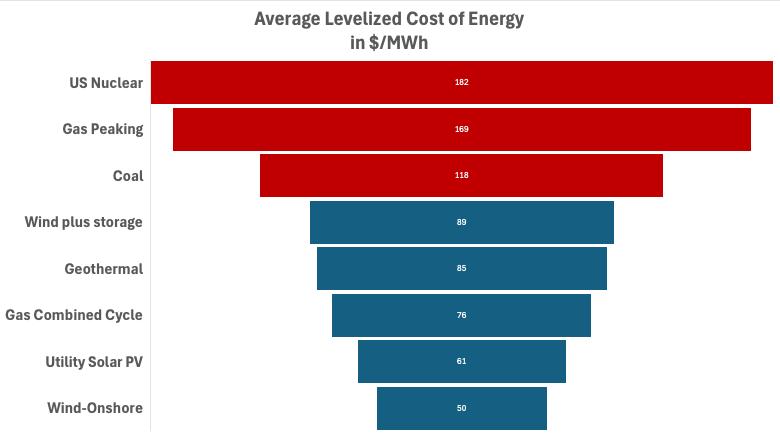
isolating Montana from the rest of the electric grid.
Montana already has the highest electricity rates in the region, thanks to our monopoly utility, NorthWestern Energy. One large industrial customer recently announced it was shutting down a Montana division of its business, cutting high-paying jobs and citing rising electricity costs as the primary driver of the decision. The company’s vice president told the Daily Montanan, “Energy costs are a huge concern right now in the state of Montana.” That should have been a wake-up call for the PSC, but it’s unclear if they even noticed. They’re too busy patting NorthWestern Energy on the back for a deficient, opaque, and contorted 20-year plan for Montanans’ electricity system that will benefit the corporation’s shareholders while continuing to result in higher electricity rates for its customers (see article on pg. 22).
If the Commissioners were truly concerned about affordability and reliability, they would look to the future and see that a modern, regional energy grid can solve both cost and reliability concerns. Thanks to our (albeit, aging) grid system, NorthWestern is able to buy excess power from other utilities across the West, and in turn NorthWestern is able to sell them power when they are in need. In the three short years since NorthWestern formally entered a newly developed short-term energy market to buy and sell power more efficiently, its customers have seen over $81 million dollars in benefits. Last year, NorthWestern was able
to buy and sell about 2 million megawatt-hours of electricity to other utilities around the region, which kept prices down and the lights on – all thanks to the connected transmission system across the West.
But the aging grid system needs serious attention. Much of the existing interstate electric grid was built 50-60 years ago, when the Chevy Impala and the Ford Mustang were the most popular cars on the road and The Carpenters were topping the Billboard charts. Now we have computers, cell phones, data centers, cryptocurrency, and artificial intelligence gobbling up electricity at ballooning rates, supplied by a grid that has received very little investment and is struggling to keep pace. The grid has the potential to be the lynchpin for keeping the lights on and electricity affordable, but only if there is a plan to make that happen.
In May, the Federal Energy Regulatory Commission (FERC) released an order that was intended to do just that – make a plan for better coordination of the interstate electric grid. Order 1920 was broadly hailed as a crucial step in the right direction. The final order gives states the first-go at determining who should pay for new investments in the grid. If states fail to decide who pays, FERC will be the backstop by allocating costs based on a predetermined contingency method. Even FERC’s former Trump-appointed chair, Neil
Chatterjee, said the order was “truly smart policy” and that “I would have definitely voted for it had I been at FERC.”
But the PSC apparently isn’t interested in smart policy. Nor is it interested in protecting affordable, reliable power through necessary long-term planning that prioritizes states’ input in the decision-making process. The PSC opposes the new rule, requesting a reconsideration from FERC, which is a necessary procedural step before one can sue over an order.
For years, Commissioners and NorthWestern have raised concerns about the reliability and affordability of the electricity system. Instead of looking to the future for a grid that relies on affordable and clean power generation that already exists, the Commissioners and NorthWestern are sowing fear of blackouts to justify building an unneeded, polluting gas plant and more ownership of the Colstrip plant. What they don’t mention is the fact that the gas plant will cost customers up to $2.3 billion. Nor do they say anything regarding the fact that no other utility in the U.S. is proposing to add more coal to its energy mix, let alone an outdated 40 year-old coal plant. Doubling down on coal power when the price of fuel alone for the plant has risen
37% since 2019 is a colossal economic mistake. Backof-the-envelope calculations show that the Colstrip plant owners are paying over $200 million annually for coal to fuel the plant. It’s as if NorthWestern and the PSC think they are playing with monopoly money when these costs are really covered by NorthWestern’s customers’ hard earned dollars.
But the PSC’s most recent decision is the icing on the unscrupulous cake. When the January cold snap hit, half of the Colstrip plant was offline for socalled “maintenance” – something that is extremely atypical in the depth of winter. Fortunately, wind power was going gangbusters as the storm blew in and temperatures plummeted. Meanwhile, 750 megawatts of “reliable” fossil fuel power didn't show up because the coal plant was broken and NorthWestern’s gas plants were not operating at full tilt either. What saved Montana customers from rolling blackouts? Sharing power with other states.
Unfortunately, Montanans seem stuck with a PSC that is more interested in partisan politics and enriching utility shareholders than planning ahead to provide affordable and reliable electricity for current and future Montana families and businesses.

by Derf Johnson
Anyone who’s stood next to train tracks in Montana or floated under a railroad bridge knows that coal trains pollute. Full stop. This huge, nationwide problem was the subject of a March 1 hearing with the U.S. Environmental Protection Agency (EPA) in which citizens and environmental watchdogs across the country demanded that the EPA require more mitigation measures, such as covering coal train cars, in order to avoid coal dust pollution. The meeting was held by the EPA in response to a petition filed by the Sierra Club, MEIC, Montana Elders for a Livable Tomorrow, and several other organizations calling upon the agency to stop harmful coal pollution from open-top trains carrying coal by requiring coal train operators to obtain a permit for their water pollution.
Particulate matter from coal dust is associated
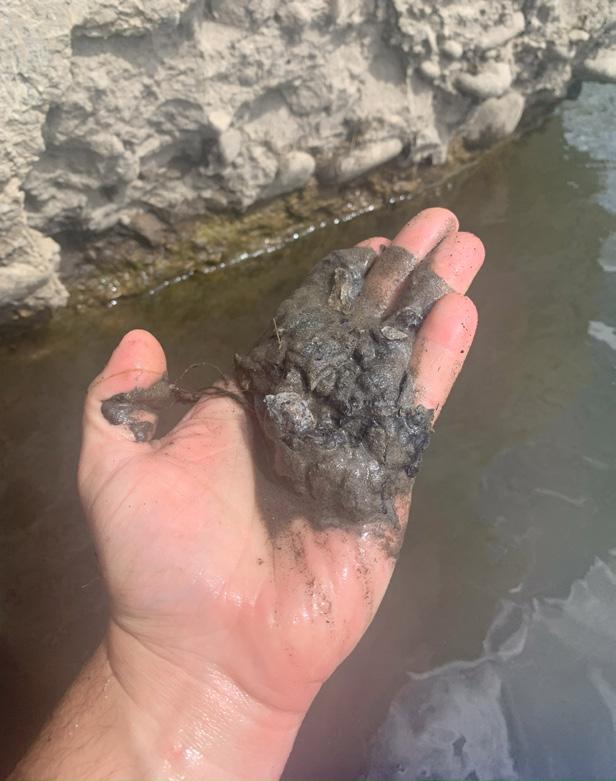
with a wide range of adverse health effects, from fetal impacts and adverse birth outcomes to more frequent asthma attacks to heart attacks and strokes. Even low levels of particulate matter pollution can cause those major health impacts. In addition, coal in Montana clearly ends up in waterways as train tracks follow rivers and streams or pass over bridges. EPA did not make any commitments at the meeting and hasn’t acted on the petition, but MEIC will keep a close watch for next steps.

by Nick Fitzmaurice
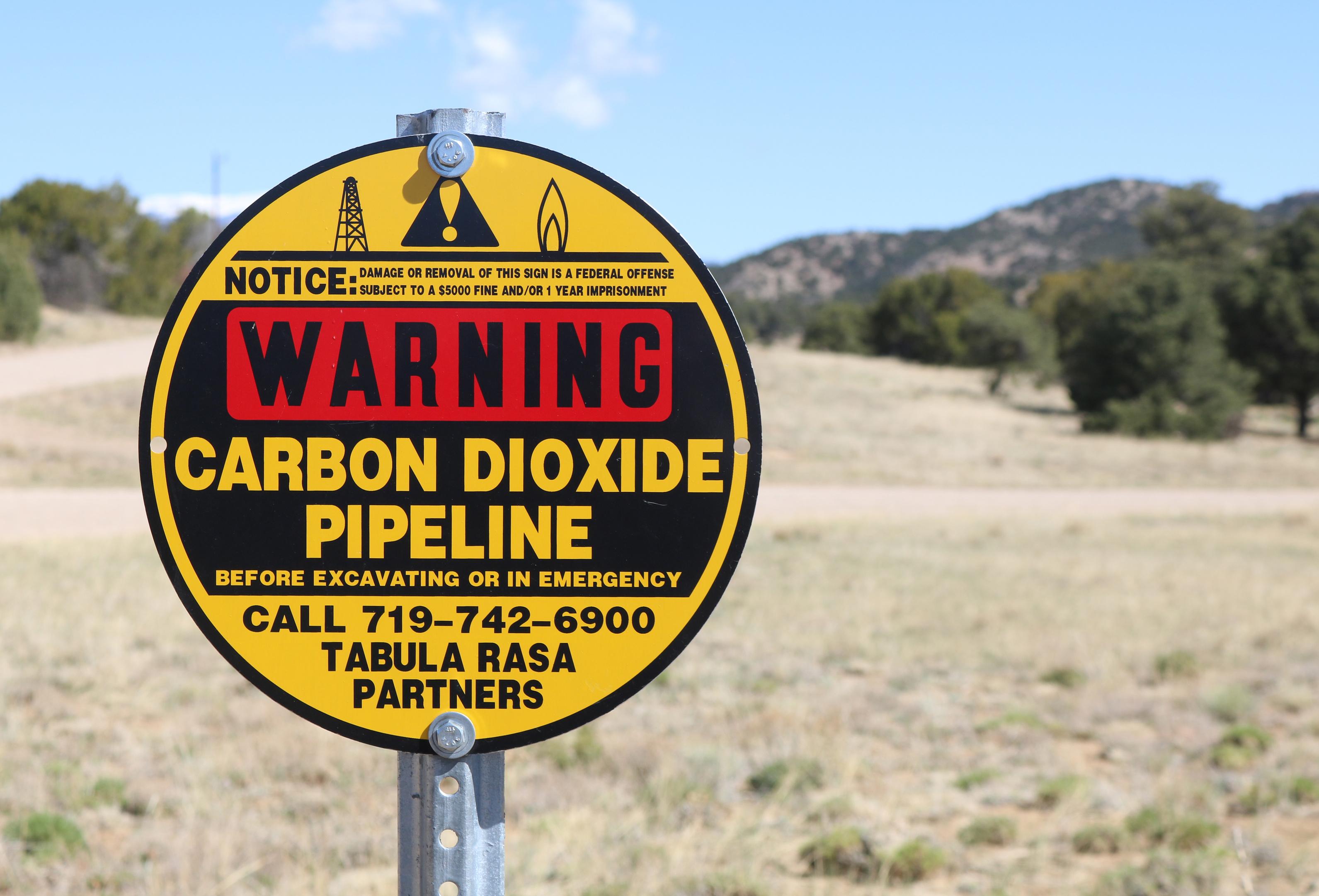
Since issuing its geologic carbon storage policy for public lands in 2022, the Bureau of Land Management (BLM) has only received applications for two proposed carbon sequestration projects on BLM lands: one in southwest Wyoming and a second in southeast Montana with the theoretical combined potential to sequester upwards of 200 million tons of CO2 over the 20-year lifetime of the projects. However, ExxonMobil Corporation (and its subsidiary Denbury Inc.) submitted both of these proposals and intends to cash out on federal carbon sequestration tax credits by simply moving CO2 from one geologic formation to another without actually mitigating the climate harms of CO2 emissions as the tax credit is intended. At $85 per ton of CO2, Exxon could theoretically rake in up to $17 billion in federal tax dollars from these two projects.
The project in Montana is the larger of the two, with CO2 sourced primarily from ExxonMobil’s Shute Creek gas processing plant in Wyoming, along with supplemental gas from Wyoming’s Lost Cabin gas processing plant. CO2 captured at these gas processing facilities is pulled directly from the ground and would not be entering the atmosphere if not for the operations at and upstream of these facilities.
Specifically, the Shute Creek Treating Facility (SCTF) processes gas that is primarily CO2, not methane. In fact, this is the lowest methane-content fossil gas that is commercially processed for methane anywhere in the world, only made economically viable when there is a secondary market for the CO2 removed from the gas. Historically, that CO2 has been sold for Enhanced Oil Recovery (EOR) where it is injected into active oil wells to produce more climate-damaging fuels (with unsold CO2 vented directly into the atmosphere). With diminishing EOR markets, Exxon is now seeking a lifeline in these carbon sequestration tax credits.
SCTF was originally built with carbon capture technology, but over its lifetime it has vented approximately 50% of processed CO2 directly into the atmosphere, totaling over 130 million tons of CO2 emissions as of 2022. In the best-case sequestration scenario, SCTF capture technology would still emit about 2.5 million tons of CO2 annually, or 50 million tons of CO2 over the 20-year lifetime of Denbury’s sequestration project. This excludes other emission sources upstream and downstream of SCTF, such as CO2, methane, or other greenhouse gases leaking in gas extraction, gas transportation to SCTF, CO2 pipeline transportation, or long-term leakage from the geologic storage site. Denbury’s sequestration project enables and guarantees the continuation of all of these
emissions sources.
To perform its exploitative maneuver, Exxon must transport compressed CO2 through pipelines more than 500 miles over land from its extraction site to the proposed injection wells in Montana. This poses tremendous safety risks as pipelines are prone to undetected leaks. Because isolated CO2 is heavier than ambient air, CO2 from pipeline leaks accumulates in valleys and depressions, creating the danger of asphyxiation and death in these locations.
CO
2 pipelines already used for EOR in Montana have been known to rupture explosively, leaving craters on public and private land. Many landowners near existing and proposed CO2 pipelines in eastern Montana are extremely concerned about the risks of pipeline ruptures. One rancher filed a legal complaint against Denbury in 2023 citing the mismanagement of CO2 pipelines that caused 16 identified leaks and ruptures
on his land over the course of a decade. A CO2 pipeline operated by Denbury in Mississippi ruptured in 2020 near a rural town, leading to hundreds of evacuations and nearly 50 hospitalizations.
Rather than energy-intensively capturing and sequestering some of the CO2 at these facilities, Exxon could instead thoughtfully plan for their decommissioning, replacing the energy production with cleaner, more cost-effective resources that embody a higher energy return on investment (the amount of energy produced weighed against the amount consumed in its production). Exxon could cease operation at the Shute Creek gas processing facility, saving taxpayers up to $17 billion dollars and directly mitigating the nearly 200 million tons of CO2 that would be processed at this facility over the projected 20-year lifetime of the proposed sequestration project.

by Nick Fitzmaurice
The Environmental Protection Agency’s (EPA) new vehicle pollution standard was one of many federal rules finalized this spring, requiring more than half of new car sales in the U.S. to be electric vehicles (EVs) by 2030. Nationally, petroleum fuel burned for transportation is one of the largest contributors to climate change, accounting for about 28% of the country’s greenhouse gas emissions. In Montana, transportation is the third-highest emitter behind electric power generation and agriculture, contributing about 16% of state-wide emissions.
By gradually increasing regulation on greenhouse gas and other harmful emissions from passenger vehicle tailpipe exhaust, the rule encourages cleaner and safer automobile manufacturing to the benefit of public health, the economy, and the environment. This rule will prevent over seven billion tons of CO2 emissions over the next 30 years, equivalent to a year’s worth of economy-wide emissions in the U.S. It will also result in nearly $100 billion in annual net benefits to society, including approximately $6,000 in annual savings for the average driver through reduced fuel and
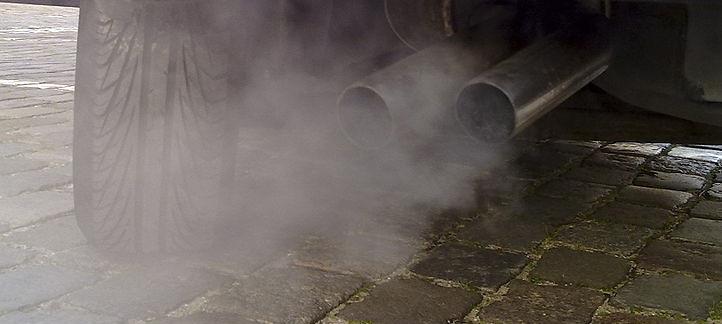
maintenance costs.
MEIC has spoken up to Montana’s congressional delegation to protect this rule in response to a sevenfigure campaign launched by the fossil fuel industry to reverse it. Contrary to industry claims, this rule is not an EV mandate, nor is it a ban on the sale of gas cars. These standards apply across automobile fleets, allowing manufacturers to continue providing various vehicle options to customers as long as the overall fleet meets the pollution requirements. The new rule addresses one of the nation’s largest sources of climatedamaging greenhouse gases as a critical step towards decarbonizing all sectors of the U.S. economy, saving lives, bolstering economic productivity, and reducing damage to Montana’s natural resources and public health.


by Nick Fitzmaurice
MEIC continues to bring its concerns regarding climate change to the doorstep of the Montana Public Service Commission (PSC). With direct regulatory oversight of monopoly utilities such as NorthWestern Energy — whose fossil fuel infrastructure drives Montana’s climate-altering pollution — the elected PSC has the potential to be the most impactful body in the state to mitigate the climate crisis. The PSC is also constitutionally obligated to do so. Given our current PSC’s history of bowing to NorthWestern’s fossil fuel interests, it is disappointing but expected that the PSC would do everything in its power to resist complying with this obligation. However, MEIC did not expect the PSC to so blatantly disregard Montana’s legal requirements.
The Montana Legislature has granted the PSC broad rulemaking authority to implement its duties, such as considering climate risk, and has empowered citizens to request rule promulgation by state agencies. So, MEIC, along with key partners Families for a Livable Climate and Gallatin Valley Sunrise, convened a group of over 40 Montana businesses and organizations to file a formal rulemaking petition with the PSC in February. This petition requests that the agency formalize a consideration of climate impacts into its procedural rules for regulating Montana gas
and electric utilities. This petition also asserts that the PSC must abide by Montana’s Constitutional right to a clean and healthful environment, which includes a healthy climate for present and future generations.
MEIC’s March Down to Earth publication details the PSC’s obligation to consider climate impacts in light of similar considerations from government entities in other states as the most equitable approach to protecting consumers from rising utility costs. Carbonfree wind and solar energy are more cost-effective than fossil fuel sources and can support a reliable grid when integrated with storage, regional power sharing, and advanced grid balancing technologies.
The PSC granted a public hearing for this petition on April 8, where over 50 individuals packed the PSC’s meeting rooms to express their support for the proposed rule. These members of the public cited a breadth of reasons for considering climate impacts, including the economic benefits of considering climate change and the economic downfalls of ignoring it. Hundreds of extensive and detailed written and oral comments have
been submitted regarding the petition – more engagement than the PSC has ever received on a single issue in
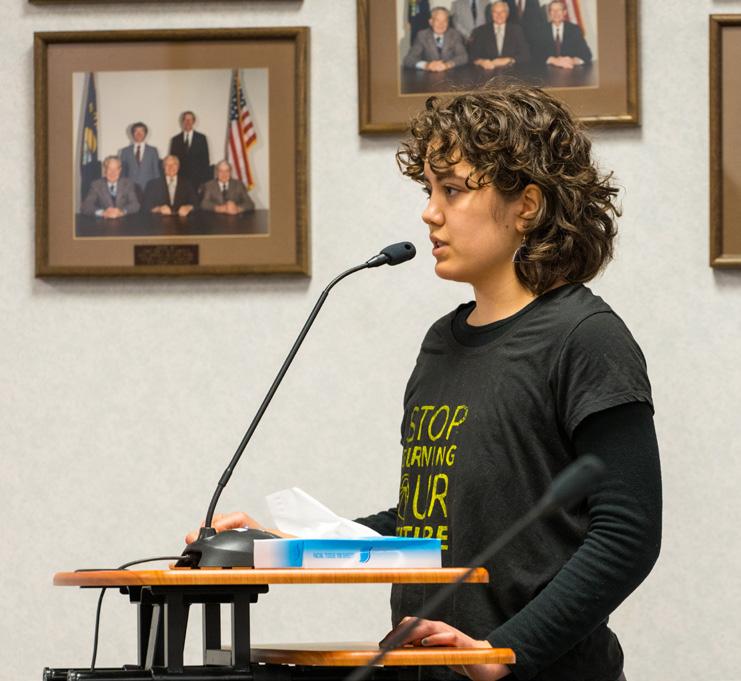
MEIC’s memory.
According to Montana law, state agencies have 60 days after a petition for rulemaking is filed to either deny the petition in writing or initiate rulemaking proceedings, and the PSC must base its decision on record evidence. This deadline elapsed on April 28, and the series of events that followed is unprecedented. On April 30, the PSC voted to extend the public comment period through July 1, claiming to be interested in gathering more input from the public.
On May 9, petitioners submitted a filing with the PSC highlighting the overdue requirement to comply with the 60-day deadline to accept or reject the petition for rulemaking. At the next PSC business meeting on May 28, Commissioners made no direct mention of this filing, while rejecting a motion from Commissioner Annie Bukacek to deny the petition.
While public participation is essential and MEIC normally goes to the mat to ensure adequate opportunity for public input, the PSC would have further opportunity to engage the public after accepting the petition and initiating rulemaking proceedings. The PSC has made explicit that they were not accepting or denying the petition by extending the public comment deadline, which is not an option legally available to them. MEIC and fellow petitioners are concerned that this is a stall tactic designed to run the petition into a statutory prohibition on agency rulemaking during the three months prior to a legislative session. Essentially, no new agency rules can be adopted beginning October 1. The decision to substantially extend the public comment period will significantly delay a decision from the PSC, if not prevent one altogether, inflicting further constitutional harm to petitioners and all Montanans.
Petitioners had hoped the PSC would comply with the Constitution, but Commissioners are making it increasingly clear that they are unwilling to fulfill their obligation to the State and are not concerned with serving the members of the public who elected them. Commissioners refuse to heed the pleas from hundreds of individuals, organizations, and businesses across the state to protect ratepayers from the costs and risks of
story continues on pg. 26
*Families for a Livable Climate
*Gallatin Valley Sunrise
* MEIC
Associated Students of Montana
State University
Big Sky Resort
Blackfoot River Brewery,
Bozeman Community Food Co-op
Bridger Bowl Ski Area
Bridgercare
Campus Climate Coalition
*Citizens for Clean Energy, Inc.
Climate Smart Glacier Country
*Climate Smart Missoula
Earthworks
Environmental Defense Fund
Forward Montana
*Helena Hunters and Anglers
Helena Interfaith Climate Advocates
Held Plaintiff Lander Busse
Moms Clean Air Force
Montana Associated Students
*Montana Chapter of the American Academy of Pediatrics
Montana Conservation Elders
Montana Health Professionals for a Healthy Climate
Montana Interfaith Power & Light
Montana Public Interest Research Group
Montana Renewable Energy Association
Montana Science Center
Montana Wildlife Federation
Natural Resources Defense Council
*Northern Plains Resource Council
NW Energy Coalition
*Park County Environmental Council
Parks’ Fly Shop
Renewable Northwest
Save Wild Trout
Sierra Club - Montana Chapter
Stonetree Climbing Gym
Ten Mile Creek Brewery
Upper Missouri Waterkeeper
Yellowstone Valley Citizens Council
*350 Montana
*Also joined the writ of mandamus

by Derf Johnson
Held v. State of Montana made some waves across not just Montana, but the world. In the ruling, a Montana District Court judge ordered that the state of Montana was failing in its duty to maintain and improve a clean and healthful environment by intentionally avoiding the consideration and mitigation of climate change. Following the groundbreaking ruling in Held, the Montana Department of Environmental Quality (DEQ) began a stakeholder process on ideas to both “reform” and “update” the Montana Environmental Policy Act (MEPA) and how to consider a project's climate change impacts. Last fall, a series of listening sessions were held, and this spring, a stakeholder group routinely convened to deliberate on and suggest reforms to MEPA processes. There’s good ideas, bad ideas, and some terrible ideas.
The stakeholder group ultimately broke out into three subgroups and made recommendations to the full stakeholder group for consideration. These subgroups include the Climate Analysis Subgroup; the Process and Applicability Subgroup; and the Public Engagement & Education Subgroup. Notably, as a whole, the stakeholder group thought that MEPA would benefit from more broad and robust public engagement and participation; more transparency surrounding MEPA decisions; and more readily available information about MEPA. Much of these recommendations were driven by the Public Engagement & Education Subgroup, but the other Subgroups agree.
The biggest disagreement MEIC has is in regard to the Process and Applicability Subgroup’s second recommendation, which calls for a wholesale revision
to MEPA to render it virtually meaningless by passing legislation to “clarify the legislative intent that MEPA is procedural, and distinctly different from the substantive statutes that regulate environmental impacts.” Basically, if put into effect, such a recommendation would render MEPA to be only a “procedural” exercise and not require a “substantive” evaluation of a project's impacts on the environment. The recommendation also includes a suggestion that, should a MEPA document be deemed insufficient, the law be changed to “limit the ability of procedural challenges to hold up permits that could otherwise be issued based on technical analysis conducted for those individual permits.”
These changes would be a catastrophe for environmental protections in Montana, primarily because MEPA serves the unique purpose of being both a public engagement and education tool as well as a “one-stop” evaluation document that considers the impacts of a project before it is permitted (“look before you leap”). Rendering MEPA a paper exercise without a strong, substantive purpose and recourse for the public (and a disincentive for DEQ to actually do a good job on MEPA analyses) would seriously undermine our constitutional rights and responsibilities.
MEIC also believes that the recommendations of the Climate Analysis Subgroup fell short. While the recommendations offered a good start and are the product of compromise, they failed to include critical recommendations to assure that a climate analysis in a MEPA review is both scientifically robust and lawful. Most importantly, the recommendations did not suggest or encourage that DEQ consider secondary or Scope III emissions, and failed to recommend that DEQ utilize the Social Cost of Greenhouse Gases (SCGHG) as a metric to better characterize and contextualize the pollution caused by DEQ’s permitting actions. Regarding secondary (Scope III) emissions, DEQ
has finally begun to analyze the GHG impacts of its permitting actions in MEPA documents because of the Held ruling. Such analyses have included a calculation of the on-site emissions of GHG associated with permitting a project. For example, DEQ is now analyzing the GHG emissions generated from operating machinery at a coal mine seeking a permit. However, DEQ is not considering the inevitable combustion of the coal, which will result in millions of tons of GHG emissions each year. Such a limited analysis minimizes or downplays the actions of DEQ by suppressing the overall emissions that would actually result from approval of the project. Failure to consider secondary emissions is ultimately nonsensical, as GHG have a very real, very direct impact on Montana, whether they are combusted in Colstrip or Shanghai.
Additionally, the SCGHG is a metric developed by the federal government to characterize and monetize the societal impacts from GHG pollution. It places a
Wdollar-per-ton cost on the climate pollution, which represents the societal costs that will be borne from releasing each ton of GHG (rising seas, air pollution, dangerous heat waves, agricultural impacts, etc).
The SCGHG is currently used by numerous federal agencies and over a dozen states in considering the impacts of climate pollution. It should have been a no-brainer for the stakeholder group to recommend its use, but politics and special interests prevailed. Without this monetary analysis, DEQ will continue to detail the economic benefits of burning fossil fuels without considering the economic harm, creating a lopsided analysis that favors the burning of fossil fuels.
DEQ and the stakeholder group took public comments on the final draft recommendations until June 24. The full list of recommendations and additional information can be viewed at www.deq.mt.gov/about/ MEPA

ith a strong desire to protect Montana’s character, treasured landscapes, and diverse communities, I join MEIC as the Sustainable Communities Planning Advocate. In this role, I develop strategies for guiding economically equitable and sustainable development, advocating for environmentally conscious community planning in Montana.
Having spent my childhood on the Northern Plains and at the edge of Appalachia, I grew up with a deep appreciation for diverse communities and landscapes. I moved to Montana from Cincinnati, Ohio, where I earned a BA in psychology and anthropology from the University of Cincinnati and pursued further education in environmental science, conservation biology, and urban design. My experience focuses on outreach and education about conservation issues, land use planning, and sustainable community development, with recent experience working as a land use planner for Missoula County.
I hold a deep respect for Montana's cultures and

history and have a strong desire to see Montana emerge as a national leader in sustainable community planning. I am thrilled by the opportunity to collaborate on strengthening and improving land use policy to guide the development of resilient and thriving Montanan communities.

by Nick Fitzmaurice
Last fall, nearly 500 people showed up at the Montana Public Service Commission (PSC) to tell the elected Commissioners that NorthWestern Energy’s 2023 Integrated Resource Plan (IRP) missed the mark by a long shot. This document is intended to outline a utility’s plans to meet customers’ energy needs over the upcoming 20 years, ensuring that utilities are prepared to provide reliable, affordable power that’s in the public’s best interest.
It is the PSC’s statutory responsibility to protect consumers by identifying deficiencies in these plans so utilities such as NorthWestern can correct their errors in future planning cycles and comply with their ongoing obligation to provide affordable, reliable power. However, since none of the Commissioners have energy backgrounds, they rely heavily on their expert staff to review and recommend action in technical analyses such as IRP reviews. It is standard practice for the PSC to make minor amendments to staff’s recommendations before approving them as the final Commission orders.
Upon completing a thorough review and analysis of NorthWestern’s 2023 IRP, the PSC staff denounced it as unsatisfactory, pointing out that “while the 2023 Plan claims to provide greater detail regarding modeling assumptions compared to the 2019 Plan, the Commission finds the 2023 Plan less transparent, accessible, and analytically rigorous than Montana’s planning statutes and the Commission’s 2023 planning rules require.” The staff detailed numerous serious “deficiencies” in the plan, often referring directly to the public testimony that first identified these deficiencies.
Rather than approving these recommendations, the PSC acted uncharacteristically and withdrew the item from their weekly agenda, requesting more time to review and alter the staff’s recommendations.
A month later, the Commission approved a heavily revised version of the staff’s recommendation produced by Commissioner Jennifer Fielder that omitted every reference to identified “deficiencies” in the plan. While
Commissioner Fielder claimed that this revised review “maintain[ed] the critical analysis provided by [staff] while incorporating 5 new statements,” large portions of the original recommendations had been deleted or altered. Commissioner Fielder tried to obscure her heavy edits by highlighting added paragraphs but not marking other revisions and deletions. These would have been easily missed without side-by-side scrutiny with the original staff recommendations, but MEIC discovered this deception through such an analysis. The substantial changes served to water down the staff’s detailed analysis and critique, devaluing the importance of stakeholder engagement and the need for better transparency throughout the IRP development process. The revisions also introduced vagaries that conveyed a murky message to NorthWestern Energy on the elements of the plan that must be improved in future IRP processes. The paragraphs that were added, while including some helpful elements, were thrown into the document haphazardly as a distraction from the pieces that were eliminated.
Opaquely gutting staff recommendations was not only disrespectful to the PSC’s expert staff, but it also hid from the public important elements of the expert critique that were intended to protect ratepayers, instead providing little guidance to ensure NorthWestern Energy plans for affordable and reliable power in future IRP processes. Even NorthWestern has admitted that no one was satisfied with its 2023 IRP, yet the Commissioners were once again inclined to bow down rather than serve as a critical agency overseeing Montana’s largest monopoly utility.
Montana utilities must develop a new IRP every three years, an iterative planning process that picks up as soon as the previous cycle concludes. We can expect NorthWestern to convene its Electricity Technical Advisory Committee (ETAC) any time to begin developing a 2026 plan. MEIC is sure to fight for a seat at the table, advocating for a reliable and affordable clean energy future.

by Derf Johnson
Industrial totalitarianism is an unfortunate, central part of Montana’s state history. Mining companies, railroads, and timber companies owned the papers and the politicians, and our political institutions were centralized into the hands of a few corrupt men who were driven by greed and a thirst for power. Our history is marked by violence against unionization, racism, and a free-for-all exploitation of the lands and waters by private interests. The government operated through backroom deals that benefited a few at the expense of the many.
Our system was broken, and the only way to readjust the balance of power and integrity in government was massive reform. Thankfully, a Constitutional Convention was called in 1972, and Montana adopted a new constitution that made significant changes to our governmental processes and the rights of individuals. Most notably, it required sunlight provisions for governmental decision-making and established fundamental rights for Montanans, including the right to a clean and healthful environment.
The “sunlight” provisions in the Constitution provide that governmental decision-making cannot take place behind closed doors, but rather public hearings and public access to documents should be part and parcel to our system of government. Specifically, Article II, Section 9 of the Constitution provides that: “No person shall be deprived of the right to examine documents or to observe the deliberations of all public bodies or agencies of state government and its subdivisions, except in cases in which the demand of individual privacy clearly exceeds the merits of public disclosure.” The provision has been subsequently interpreted by courts to clearly and unequivocally require public access to government documents, even when embarrassing or cumbersome. The courts have also recognized very limited, narrow exceptions to this constitutional right.
For the most part, state agencies have become
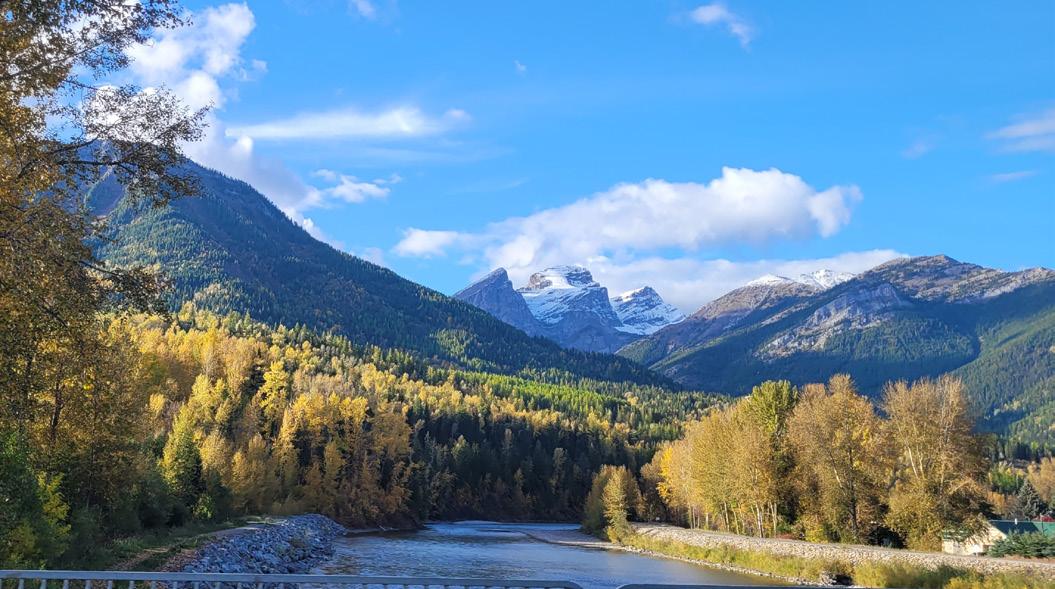
accustomed to providing public documents upon request. Cue Attorney General Austin Knudsen and the Montana Department of Justice (DOJ).
Recently, DOJ intervened in litigation regarding pollution emanating from the Teck Coal mines in the Elk Valley of British Columbia and polluting Lake Koocanusa and the Kootenay River in Montana; to everyone’s surprise, DOJ is in support of this Canadian mining corporation. If DOJ’s support for a foreign mining company operating in Canada that is polluting U.S. waters doesn’t raise your eyebrows, then perhaps its privilege claims over public documents will.
Finding DOJ’s actions both out of place and antithetical to the interests of Montanans, MEIC submitted a formal information request to DOJ for its communications with Teck Coal in early January of this year. After a prolonged back and forth ( and an exorbitant fee estimate), the DOJ ultimately denied MEIC access to the public documents, citing a “common interest privilege” with the foreign corporation. Interestingly, such a privilege has never been recognized to exist in Montana between a government entity and a party that it purportedly regulates.
DOJ’s position ultimately forced MEIC to court in April to access the documents. The documents are clearly public, and the reason for denial that DOJ asserts flies in the face of the law and Montana’s history. Unfortunately, lawsuits take time and money, but MEIC will not back down from the government’s attempt to quash and intimidate members of the public from requiring transparency and accountability for our elected officials.

by Larry Campbell, Friends of the Bitterroot Conservation Director
Friends of the Bitterroot (FOB) was immediately alarmed when mining claim owner US Critical Materials Corporation (USCM) produced a press release in 2022 promoting the Sheep Creek rare earth elements deposit. It would be nearly impossible to find a worse location for a mine in the Bitterroot.
The seven-square mile claim block at the head of the West Fork of the Bitterroot contains rich habitat where pure strain westslope cutthroat trout, bull trout, wolverine, bighorn sheep, mountain goats and elk thrive. About half the claim block lies within the Allan Mountain Inventoried Roadless Area that anchors the Continental Divide wildlife corridor, providing secure access for grizzly bears reinhabiting the Bitterroot Ecosystem Grizzly Recovery Zone. The mine would also jeopardize the high-value, time-tested renewable fishing economy of the Bitterroot. The possible boom and guaranteed bust of unsustainable mining would permanently sacrifice a generations-old, dispersed, sustainable local economy for quick out-of-state corporate profit.
Many saw the press release as a hyped sales pitch and doubt there will ever be a mine. Indeed, a full mining operation may never materialize, but a lot of damage can happen from exploration activities, including bulldozing pads, creating new roads, digging drainage holes that can introduce pollution into the aquifer. This is what FOB is presently focusing on.
Indications of possible asbestos is the most immediate concern. Given the tragedy of hundreds of preventable deaths from asbestos in Libby, Montana, we are asking the Forest Service to require USCM to hire an independent contractor to test for asbestos prior to any ground-disturbing exploration activities at Sheep Creek.
The need for independent testing is urgent, as USCM has announced it will submit a Plan of Operations this summer involving drilling. Such ground-disturbing activity would trigger the need for
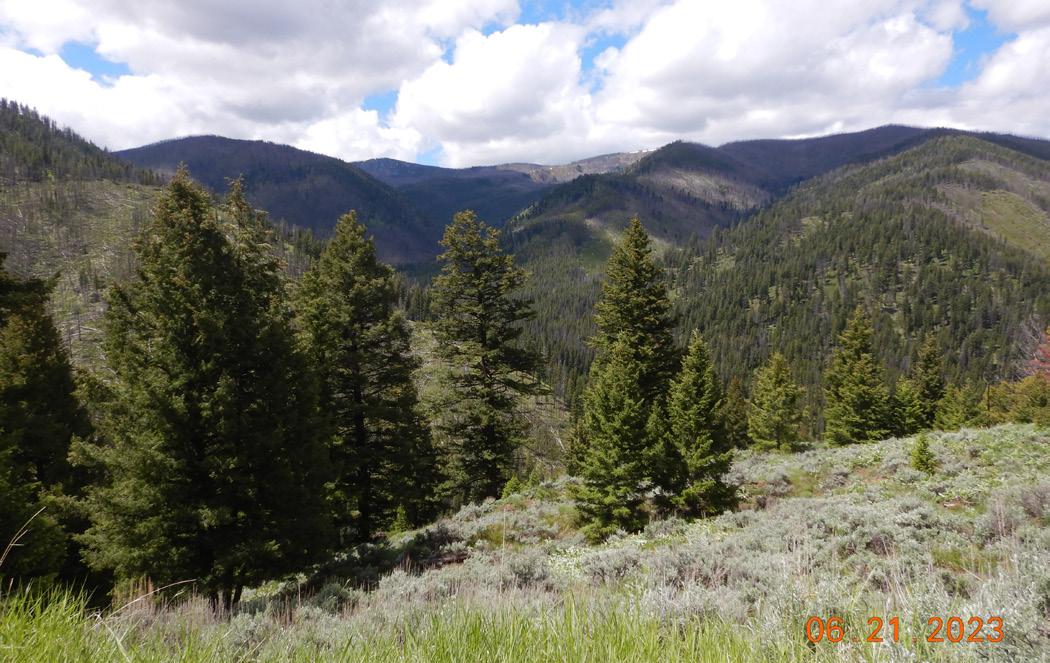
an environmental analysis pursuant to the National Environmental Policy Act, with its associated public comment opportunities. Until that time, we are asking concerned citizens to contact Bitterroot National Forest Ranger Dan Pliley, daniel.pliley@usda.gov to be notified of news regarding exploration permitting.
The federal government recently expedited permitting for “critical minerals” exploration, and the US Forest Service’s use of quick and superficial Categorical Exclusions to permit “critical mineral” exploration just over the ridge in Idaho has us worried they might do the same at Sheep Creek. This requires a rapid response for effective public opposition.
First, we researched relevant information and created a public library on Friends of the Bitterroot’s website: www.friendsofthebitterroot.net/sheep-creekmining
We also reached out to existing groups to collaborate and coordinate opposition. A coalition of 17 groups submitted a “pre-scoping comment letter” to the Bitterroot National Forest, putting both the BNF and USCM on notice about some initial concerns.
An online petition to stop the mine has over a thousand signatures: www.change.org/p/stop-thesheep-creek-mine-don-t-pollute-the-bitterroot.
Finally, an ad hoc “stop-the-mine group” is forming and is organizing public presentations: www. bitterrootcleanwater.org.

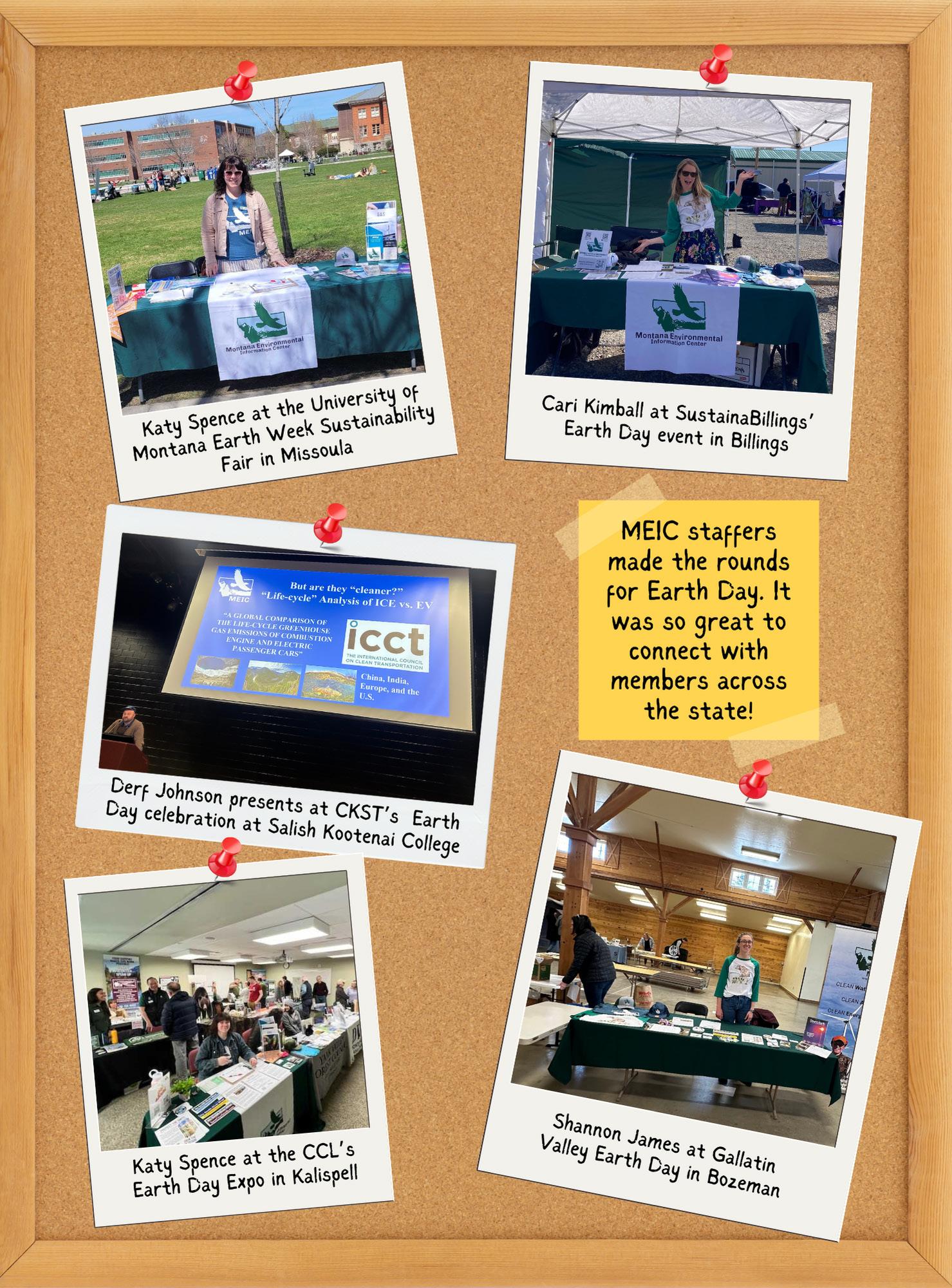
by Katy Spence and Cari Kimball
In 2023, MEIC board and staff commissioned an anti-racism audit from WiderStand Consulting.
WiderStand is a nonprofit organization whose mission is to provide anti-racism training and consultation to predominantly White institutions in both online and in-person formats.
In this process, WiderStand consultants reviewed MEIC materials, work procedures, board and staff policies, and conducted focus group discussions to identify organizational elements that might be alienating or even harmful for Black, Indigenous, and People of Color on our staff, on our board, in our community of partners and supporters, or by those impacted by our work. This process was challenging, but important – MEIC has long worked to be nondiscriminatory, but some practices and language can be so embedded that they’re hard to see unless someone points it out. Remedying those practices and language is another process entirely.
At the end of this exercise, WiderStand gave MEIC board and staff a detailed report of areas for
improvement, with suggested timelines as short as “immediately” and as long as 12 months. Since that time, we have been working to address some of these areas. We’ve started with some of the most easily addressed issues (such as updating language on our website or talking publicly about the anti-racism efforts we’re pursuing) and foundational issues like revising board and staff policies. We’re also digging into continued learning for our board and staff in order to make our work and workplace safe and productive for employees and board members of color.
We’re grateful to WiderStand and our Equity and Justice board committee for their work and guidance through this process. We will endeavor to be transparent and communicative about this process as we work through the recommendations we have received. As we do so, we realize that there may be growing pains and we’re not going to get it right overnight. We are open to feedback about this process and other parts of our work, which can be submitted anonymously if desired through our website: www.MEIC.org/about/ contact-us.

( continued from page 19)
expensive fossil fuel infrastructure. The PSC’s actions fly in the face of our Constitutional right to a clean and healthful environment.
On June 6, MEIC and a handful of other petitioners filed a Writ of Mandamus in district court. This legal action requests immediate judicial enforcement of the statutory deadline that the PSC neglected. Earthjustice and the Western Environmental Law Center have represented petitioners at the PSC, and now represent MEIC and our partners in Missoula County District Court. As of this writing, the court has ordered the PSC to formally respond by July 10 with an explanation of whether the PSC is following the law regarding petitions for rulemaking or “any alternative process.” A court hearing on the matter is scheduled for July 18.
Once the PSC makes a decision on the petition for rulemaking, MEIC and partners will assess next
steps. The Montana Constitution is clear on our right to a clean and healthful environment, which a court has already found encompasses the right to a healthy climate, and we trust that our institutions of justice and accountability will bring relief to Montanans.
MEIC will not give up this effort until the PSC considers the economic, social, and environmental implications its decisions have on the climate, incorporating the federally recommended Social Cost of Greenhouse Gases into its regulation of Montana gas and electric utilities. Last summer’s district court ruling in Held v. State of Montana filled the sails of this fundamental right that has been guaranteed yet ignored for decades. This effort will continue to advance the case for climate protection and mitigation in Montana.

by Cari Kimball
Happy Summer, friends! I hope you’re finding ways to enjoy these long daylight hours. Isn’t July in Montana dreamy?
A couple weekends ago, my family joined friends for a camping trip in the Big Belt mountains. We watched our kids collect lichencovered sticks and admired fairy slipper orchids, later spotting a rednaped sapsucker hopping up a tree.

At various moments, I thought of the kindness and generosity of MEIC’s community members who’ve helped protect Montana’s environment so we can experience this richness. Sometimes I cannot believe how lucky I am to live here and how grateful I am to those who worked to ensure that people today can enjoy this clean air, water, and these wild landscapes. And I have to say that I love the notion that, when I’m gone, someone would be reminded of me while they’re experiencing a beautiful Montana summer day in the forest or a wildflower patch.
I’ve been thinking about this more in the past couple of months as MEIC has reached an exciting milestone that we want to share with our supporters… Starting in 2025, MEIC’s board has approved for our organization to begin dedicating a portion of the earnings from MEIC’s Permanent Fund (or endowment) to grow staff capacity, build stronger partnerships, and better connect Montanans with opportunities to make their voices heard for environmental protections and our quality of life. We have many people to thank for this position of abundance and opportunity.
MEIC is wholeheartedly humbled and honored by the generosity of Arlyne Reichert, Marian Jean Setter, Farwell Smith, Adam and Nancy McLane, John Crowley, Ron and Nancy Erickson, and Hallie Rugheimer for the bequests they left to MEIC in the past year. We are so sad to have lost their camaraderie and leadership, but their commitments to providing long-term support for MEIC through planned giving are providing us with both financial support and
inspiration. Their profound love for Montana and the hope that people today and in the future will enjoy a clean and healthful environment in this state lives on with us and through our work. They have reminded us all of what we can do to leave an enduring legacy, regardless of our income level or giving ability.
MEIC’s work today will help pass along this version of Montana (or hopefully an even more clean and healthful one), and we are so honored that we will begin growing our organization’s impact thanks to the generosity and vision of our Clean and Healthful Legacy donors who have included MEIC in their will or as a beneficiary of a planned gift like an annuity. If you share this desire to leave is a more beautiful, healthy, thriving Montana when you go, there are a number of ways that you can follow in their footsteps, including:
• Leave a bequest to MEIC in your will.
• Contribute to the MEIC’s Permanent Fund endowment.
• Designate MEIC as a beneficiary in a Charitable or Deferred Gift Annuity through Montana Community Foundation.
• Give MEIC stock or other assets, either while you are living or in your will.
• Designate MEIC as a beneficiary on a life insurance policy or retirement plan.
Not only will your planned gift help protect Montana’s air, water, and land now and for future generations, you could provide yourself, your family, and other beneficiaries with significant tax benefits.
We believe that MEIC’s future is worth investing in! If you do, as well, and would like to receive more information and discuss planned giving options, please contact Cari Kimball: 406.443.2520x100 or ckimball@ MEIC.org. Or if you’ve already included MEIC in your planned giving, please let us know so we can reach out with our gratitude.

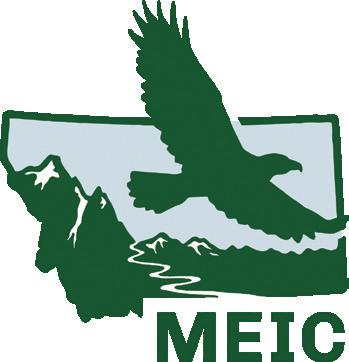
P.O. Box 1184 Helena, MT 59624
CHANGE SERVICE REQUESTED

July 31, 6:30 - 8:30 pm Beall Park Pavilion, 415 N Black Ave, Bozeman
Aug. 21, 6:00 - 8:00 pm Lewis & Clark Fairgrounds Rustic Shelter, 98 W. Custer Ave, Helena
Sept. 18, 6:00 - 8:00 pm Silver Park Shelter, 700 Cregg Ln., Missoula
